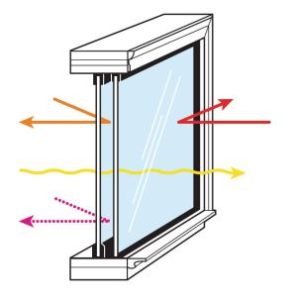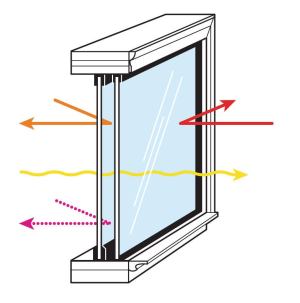

All window glass panes are not the same. Just because a new window is double-pane, doesn’t mean you’re necessarily buying the most energy-efficient window. Yes, because of increased insulation performance, a double-pane window is a step-up in saving energy and keeping your home more comfortable during the cold winter months. However, by itself, a double-pane window doesn’t help to keep your home cooler during the summer. By selecting windows with energy savings, such as low-E glass, which are also double-pane, you can ensure year-round energy-efficient windows.
Low-E glass, or low-emissivity glass, is a special type of glass that has spectrally selective coatings applied to it. The thin-film coating is specifically designed to allow only certain wavelengths of the solar spectrum to pass through the glass and enter the home, while restricting others. More specifically, it prevents solar ultraviolet wavelength energy from entering the home. The ultraviolet light is what actually warms the surface of the objects that it comes in contact with. Ultraviolet light also causes furniture fabric, carpeting and wood floors to fade over time.
Low-E glass is unlike the dark-shaded glass that was produced decades ago. The energy-saving low-E glass of today has so fine a film coating on it, that it is nearly imperceptible to the naked eye. It effectively appears clear, thus not reducing the amount of natural light into your home. Moreover, today’s low-E glass film coatings are specially designed and applied so they help keep homes cooler during the summer months and warmer during the winter months. As a result, when combined with double-pane window technology, it provides the maximum in energy savings.
When purchasing energy-saving low-E glass windows, make sure to select those appropriate for your climate region. Not all of them are the same. There are several types of spectrally selective low-E film coatings, and none are ideal for all climate regions. For example, there are some types that are more appropriate for the southwestern United States, while there are others that are more appropriate for the Northeast. As a matter of fact, the Energy Star program identifies four unique climate zones in the United States. With each climate zone, they recommend a specific type of low-E glass to be used in the windows. As a result, for those homeowners and builders participating in the Leadership in Energy and Environmental Design program to build energy-efficient rated homes, they must use the specific type for their region, as recommended by the government.
For example, the Energy Star program recommends homes built in the Northern and Central regions of the United States to use “Moderate Solar Gain Low-E Glass Windows.” These types of windows are specially designed to screen out a high percentage of the sun’s ultraviolet light during the summer months and a lower percentage during the winter months, when the added solar heating is desired. In the Southwest portion of the country, however, the government’s Energy Star program recommends using “Low Solar Gain Low-E Windows.” These windows let in even less ultraviolet sunlight and heat during the summer months.
To learn more about spectrally selective low-E glass and other ways to make your home more energy efficient, visit EnergyStar.gov.
This article was contributed by Mark J. Donovan.
 Related Articles & Free Subscription
Related Articles & Free Subscription
Every Home’s Free Heating and Cooling Devices
Making Your Home Cooler Without an Air Conditioner







Comment here